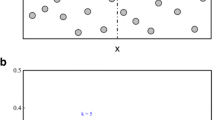Based on the proposed stochastic model for the formation of rarefied flows, an analysis of the first stage of rotary mixing of polymer secondary and primary components using a three-row blade sprayer at the preliminary stage of the injection molding machine operation has been carried out. The most significant factors influencing the degree of efficiency of indicated rotary mixing have been established. It is shown that for the maxima of the corresponding differential distribution functions of the number of particles of polymer components, the extreme values of the scattering angles approach each other. In particular, the ratio of these angles for primary and secondary polypropylene corresponds to a value of 1.2.




Similar content being viewed by others
References
P. Tratzi, C. Giuliani, et al., “Effect of hard plastic waste on the quality of recycled polypropylene blends,” Recycling, 6, No. 3, 58 (2021).
M. W. M. Cunico, D. A. Kai, P. M. Cavalheiro, and J. de Carvalho, “Development and characterization of 3D printing finishing process applying recycled plastic waste,” Virtual Phys. Prototyp., 14, No. 1, 37–52 (2019).
Russian Federation Patent 2749510, IPC B 01 F 3/18, B 01 F 5/04, B 01 F 7/00, B 01 F 9/10, Bulk Material Mixer [in Russian], claimed by A. E. Lebedev, A. B. Kapranova, and D. V. Stenko, No. 17 (2021).
A. B. Kapranova, I. I. Verloka, and D. D. Bahaeva, “About preparation of the analytical platform for creation of a cyber-physical system of industrial mixture of loose components,” in: Cyber-Physical Systems: Advances in Design & Modelling, Springer, Cham (2020).
A. B. Kapranova, D. D. Bahaeva, D. V. Stenko, and I. I. Verloka, “A model of rotational mixing of loose environment on the platform of cyber-physical systems,” in: Cyber-Physical Systems: Design and Application for Industry 4.0, Springer, Cham (2021).
S. N. Cherpitsky, M. Yu. Tarshis, L. V. Korolev, and A. B. Kapranova, “Investigation of the process of mixing bulk materials in a drum-blade mixer,” Khim. Neftegaz. Mashinostr., 56, No. 1, 3–6 (2020).
A. Kapranova, D. Bahaeva, et al., “Distribution of the components of the building mixture in the presence of secondary raw materials during rotary mixing,” E3S Web Conf., 220, 01060 (2020).
A. Kapranova, D. Bahaeva, et al., “Stochastic analysis of impact mixing of bulk materials in a rotary apparatus,” E3S Web Conf., 247, 01048 (2021).
Yu. L. Klimontovich, Turbulent Motion and the Structure of Chaos: A New Approach to the Statistical Theory of Open Systems [in Russian], LENAND, Moscow (2014).
A. B. Kapranova, A. E. Lebedev, D. O. Bytev, and A. I. Zaitsev, “Stochastic description of the motion of a clarified powder suspension fraction,” Izv. VUZ. Khim. Khim. Tekhnol., 47, No. 6, 99–101 (2004).
A. B. Kapranova, I. I. Verloka, et al., “To the calculation of the average value of the volume fraction of the key bulk component at the intermediate stage of mixing with an inclined bump,” Front. Energy Res., 8, 135 (2020).
A. B. Kapranova, M. N. Bakin, and I. I. Verloka, “Modeling the mixture quality criterion in the volume of a drum-tape device,” Khim. Neftegaz. Mashinostr., 54, No. 5, 3–9 (2018).
A. B. Kapranova and I. I. Verloka, “Stochastic description of the formation of flows of particulate components in apparatuses with brush elements,” Teor. Osn. Khim. Tekhnol., 52, No. 6, 707–721 (2018).
A. E. Lebedev, A. B. Kapranova, A. A. Vatagin, and A. M. Melzer, “Study of the formation of cavitation bubbles in a new axial control valve with a rotational movement of the locking body,” Khim. Neftegaz. Mashinostr., 56, No. 7, 11–13 (2020).
A. Kapranova, D. Bahaeva, et al., “Methods of nonequilibrium statistical mechanics in models for mixing bulk components,” in: Modeling and Simulation in Engineering, IntechOpen, London (2020).
Author information
Authors and Affiliations
Corresponding author
Additional information
Translated from Khimicheskoe i Neftegazovoe Mashinostroenie, Vol. 57, No. 11, pp. 16−21, November, 2021.
Rights and permissions
About this article
Cite this article
Stenko, D.V., Kapranova, A.B., Bakhaeva, D.D. et al. Stochastic Analysis of Rotary Mixing of Polymer Components in the Framework of Recycling and Development of 3D-Printing Technologies. Chem Petrol Eng 57, 920–929 (2022). https://doi.org/10.1007/s10556-022-01027-x
Published:
Issue Date:
DOI: https://doi.org/10.1007/s10556-022-01027-x




